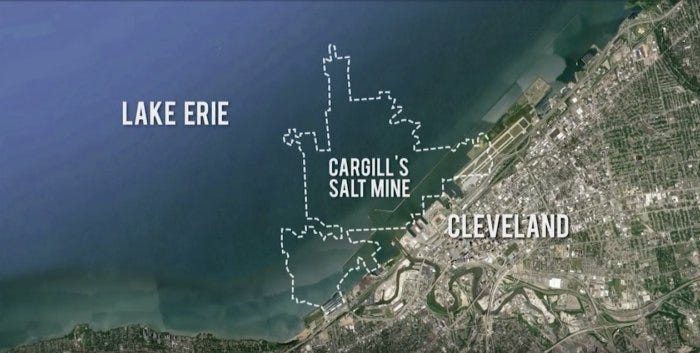Back to the Salt Mine: Labor Where You Least Expect It
This New Year's, follow the lead of gratitude experts Mick Jagger and Keith Richards: "Let's drink to the hard workin' people. Let's drink to the salt of the earth."
Gazing out over Lake Erie from the Cleveland waterfront, you’re likely to see commercial and recreational watercraft. You’ll see white-capped waves and, in winter, ice floes. But you may be in the dark about what lies beneath — not underwater, not on the lakebed, but 1800 feet further down in the direction of earth’s core.
Under Lake Erie lies Cargill’s Whiskey Island salt mine, actively worked round-the-clock by about 250 miners, extracting salt used largely for de-icing wintry roads.
Salt mines are scattered throughout the world, including Morton’s Fairport Harbor mine, also beneath Lake Erie, 30 miles east of Whiskey Island.
Another sprawls under a major US city:
The gigantic salt mine is located 1,200 feet beneath Detroit’s surface, spreads out more than 1,500 acres, and has over 100 miles of underground roads. — Detroit Salt Company
Beneath Lake Huron, Canada lays claim to a 13,195-acre expanse considered the world’s largest underground salt mine.

I’ve spent a lot of time on the campus of Cornell University, known for its vistas over Cayuga Lake in New York State’s picturesque Finger Lakes region, and I’ve frequented the lakeside farmers’ market. Until recently, however, I didn’t know that while I gingerly palpate the vendors’ produce for bruises and imperfections, as other customers arrive by kayak and pontoon boat, workers are industriously drilling, blasting, and loading in North America’s deepest salt mine… beneath the lake.
Not all salt mines are under bodies of water. Like many residents of northeast states, I regularly use American Rock Salt products to manage my steep driveway during winter, and I periodically drive past the company’s processing operation (gravitating to it so strongly that, a few years back, I pulled over to take a selfie in front of their sign, oblivious to the labor taking place below). The company’s salt mine is one of many hollowed out under dry land, though groundwater aquifers may still run above the mine’s roofs.

Salt miners depend on heavy machinery (usually re-assembled in the mine after being lowered down in sections); on explosives (the mines are so deep you’ll almost never hear the frequent blasts); and on each other. A mining credo: “The most important thing to come out of a mine is the miner.”
When Heigh Ho returns in January, I’ll feature an exclusive Q&A with a salt miner who works 10-hour shifts in a 2400-foot vertical mine shaft. To envision the depth, imagine two Empire State Buildings stacked one atop the other. (Now imagine yourself in the middle of that shaft, where you wouldn’t see your hand in front of your face if your helmet light went out.)
The miner, Justin, describes…
how he got into mining;
the mine’s sights, sounds, and smells;
the job’s wages and benefits;
working with explosives;
teamwork and safety culture;
the future of work in salt mines;
his time off to hike the entire Appalachian Trail;
his encounters with people surprised to learn that miners still exist.
You’ll find Justin’s story to be transformative. Since reviewing his responses to my questions, I sometimes lie awake at night, safe in my comfortable bed in my comfortable house, awestruck by the hardy souls who at that very moment — at this very moment — toil in the deep.
Reflecting on those doing one of society’s least visible jobs unearths our own authentic values about work and working life.
Whet your appetite for more with this article and its 12 stunning photos of the Fairport Harbor mine, or watch the short video, below, for more about the Cargill mine and employee experience.
(Unrelated to salt mining in industrialized countries, you may also be interested in Minors as Miners, from a previous Heigh Ho post.)
Let me stress what lies ahead in Heigh Ho…
I’m laying the groundwork for an eye-opening series of posts about one of our most stressful jobs. We’ll do a case study of a well known employer; summarize all we know about how the job affects health and wellness; peer into data from the employer’s survey of employee satisfaction, engagement, and trust; and talk to at least one of the organization’s frontline workers. It’ll be a mash-up that promises actionable insights relevant to almost any job — including yours.
Stay tuned for this one-of-a-kind content and more innovations in the year to come. Good stuff for workers; essential reading for any leader worth their salt.
And Now, With Eyes on the New Year…






Really interesting intro and very much looking forward to your interview with Justin, Bob. Love that you're educating us on occupations we might miss and the challenges workers face. Always enlightening and entertaining too.
Fascinating! Had no idea the mines were so deep. Want to learn more - looking forward to your interview.